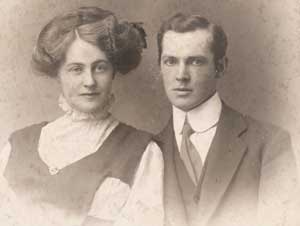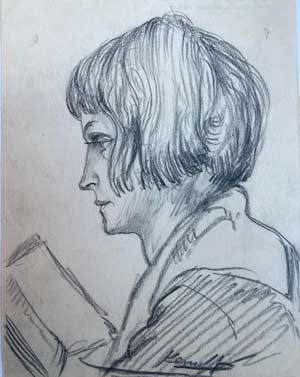The many parts of Daisy Bannard Cogley
Published in Features, Issue 5 (September/October 2022), Volume 30By Elaine Sisson and Brian Trench

Above: Daisy Bannard and Fred Cogley at the time of their marriage in Santiago, Chile, in 1910. (Cogley family collection)
When Eamon de Valera was released from prison in July 1924, among the select few invited to a welcome party at a private house was Mrs Cogley, who sat with Rosamond Jacob and Mary MacSwiney on the stairs as they watched de Valera eat a chocolate éclair and drink a cup of coffee. Although she left no archive of her own, ‘Mrs Cogley’ appears frequently in the memoirs and letters of others. She has walk-on parts in stories about Jacob’s, MacSwiney’s, Margaret Buckley’s (later president of Sinn Féin) and Dorothy Macardle’s imprisonment in the Civil War and about Máire O’Brien’s diplomatic efforts in the 1920s on behalf of the Republic.
But ‘Mrs Cogley’ hardly does justice to a very remarkable personality. As Johanna Mary Cogley she was awarded a military service pension for activities that included storing arms and ammunition, providing a safe house and managing The Irish Bulletin during the War of Independence. She was also known in republican circles as Noinín, and commonly as ‘Madame’—one of the ‘four Madames’ (with Despard, Markievicz and Kirkwood-Hackett) prominent in the political and cultural scene of the 1920s. However, as Désirée, Daisy or Toto Bannard Cogley she was a leading presence in the Dublin theatre world for over forty years.
Family background
Born in Paris in 1884 to a French father and County Wexford mother, she straddled languages and cultures. She was a student at the Sorbonne, Conservatoire and Comédie Française, training as an actor and singer, and her family had a route into higher French society mapped out for her. But on a visit to her mother’s family (Carter) in Enniscorthy she met a young nationalist journalist from Wexford town, Fred Cogley. They both made their way to Santiago, Chile, and married there. Their first son, Mitchel, was born in Santiago in 1910; he was later a legendary sports editor with the Irish Independent.
Fred Cogley had earlier been friendly with Robert Brennan, also from Wexford, and active with him in the Gaelic League and Sinn Féin. When Cogley and Bannard Cogley returned to Ireland in 1913, Brennan introduced them to militant circles. Cogley wrote for Irish Freedom, and was employed in the Irish Independent, while Bannard Cogley took part in various nationalist and radical cultural initiatives. In 1914 she and Countess Markievicz took part in a fete organised by the Irish Women’s Franchise League (IWFL), when Bannard Cogley sang the Women’s Marseillaise, a suffragist anthem to the tune of the French national anthem.
In those early years in Dublin, she performed as a soprano singer of operatic arias, modern French songs and folk or labour songs. She was also an active member of Edward Martyn’s Irish Theatre Company in Hardwicke Street, appearing under the stage name Helen Carter. She played Madame Ranevesky in the first Irish production of Chekhov’s The Cherry Orchard, directed by John MacDonagh, brother of Thomas, in 1919. She took part in numerous concerts and stage productions in Dublin venues, including at the Little Theatre in Upper Sackville Street, one of many ‘little’ or ‘studio’ theatres she was associated with, or established, at locations across the city.
As well as contributing her musical and theatrical skills to the IWFL, over the following decades Bannard Cogley performed, directed, produced, designed, sang or otherwise took part in entertainments undertaken by, or raising funds for, the Liberty Hall Players (ITWGU), Irish Republican Prisoners’ Dependents Fund, Jewish Drama Society, Save the Children Fund, Radical Club, New Theatre Group, along with many others.
From 1919, Fred Cogley was writing for The Irish Bulletin, a mimeographed daily, which was edited at various times by Robert Brennan, Desmond FitzGerald and Erskine Childers, though Bannard Cogley stated in her application for a military service pension that she was ‘in charge’ of it. She also carried IRA dispatches to London and Paris.

Above: One of several drawings of Bannard Cogley by Harry Kernoff. They were professionally and personally close. (Cogley family collection)
Anti-Treaty
After the outbreak of the Civil War, the Cogleys actively supported the anti-Treaty forces, and were imprisoned, Daisy for three months and Fred for nearly a year. The corner of the women’s prison where she was held was known as ‘Suffolk Street’, as a raid on the Sinn Féin offices there in 1922 yielded so many of the women prisoners. In December 1922, both Cogleys were in Mountjoy, in separate wings, and both provided music for Christmas masses and entertainments. Bannard Cogley directed plays written for the prisoners by Dorothy Macardle and sang her support for Mary MacSwiney on hunger strike.
Fred Cogley was later held in the Curragh, Newbridge prison and Gormanston camp, where he took part in the hunger strike that started in October 1923. While he was interned, Bannard Cogley attended the August 1923 World Congress in Geneva of the International Red Cross on behalf of the ‘government’ of anti-Treaty TDs. Despite having no formal delegate credentials, she and Máire O’Brien got to speak to the congress in French about the conditions of republican prisoners.
After the Civil War, the new radio service 2RN and Egan’s art gallery on St Stephen’s Green provided platforms for Bannard Cogley’s musical presentations. She also staged revues and cabarets at Egan’s and elsewhere under various banners, including the Radical Club, The Thalia and Studio Cabaret. The Cogleys had extensive social networks and knew most of the key players in Dublin intellectual life but their life together came under strain. By 1927 Fred Cogley was in London, having left debts unpaid in Dublin, as Daisy told Rosamond Jacob.
From Jacob’s diaries it appears that Madame was running the family and her business almost singlehandedly. From May 1927 she was hosting weekly cabarets at her Little Theatre in South William Street. She also organised cabaret interludes at charity dances, such as those of the Save the Children Fund and the Herald Boot Fund. On a larger canvas Bannard Cogley co-wrote and produced pageants, designing the costumes for, and taking part with 500 others in, a 1927 Pageant and Tableaux at the Mansion House depicting Irish history, where she ‘infused quite a lot of humour and not a little irony’, according to the Irish Independent.
Hilton Edwards and Micheál MacLiammóir
In 1928 Bannard Cogley met Hilton Edwards and Micheál MacLiammóir. Edwards recognising her as ‘a like-minded individual’. She gave them their first Dublin stage appearances in one of her Saturday evening cabarets. She had recruited a theatre club membership of 400 through whom funds were raised and an audience built for the Edwards-MacLiammóir production of Peer Gynt at the Peacock Theatre in October 1928, the first of hundreds of productions from the formidable pair.
Bannard Cogley and her actor-playwright friend and cabaret colleague Gearóid Ó Lochlainn became founding directors with Edwards and MacLiammóir of the new Gate Theatre. Bannard Cogley was responsible for costumes at the Gate in its earliest years, and also served as business director for a short period. This was a role for which she considered herself unsuited, though for some years in the mid-1920s she ran a dress-making business in Molesworth Street, also selling French and Irish goods, ‘millinery, costumes, afternoon and evening gowns, coats, jumpers, etc.’, as advertised in Honesty, a radical newspaper.
Close to Harry Kernoff
Alongside presenting Denis Johnston’s The Old Lady Says No, rejected by the Abbey Theatre, and works by Maeterlinck and Gogol, the Gate continued the Bannard Cogley tradition of revues, including a ‘very realistic’ gypsy presentation in January 1930 at the Nine Arts Ball, Gresham Hotel, that featured, among others, the Gate directors, republican Bulmer Hobson and painter Harry Kernoff.
Bannard Cogley and Kernoff were professionally and personally close; he designed and painted sets for her productions, painted and drew many portraits of her, and painted a view of the bonded warehouse beside Harcourt Street station from the window of her club premises. In London, Fred Cogley had found work in Fleet Street newspapers and agencies. Bannard Cogley and teenage son Fergus joined him in 1931. She established The Green Curtain theatre group, which put on new plays by Irish authors. Mother and son also appeared in 1935 in Leslie Daiken’s dramatized version of The Rebel by Patrick Pearse, produced by a stage group associated with the Republican Congress.
Fred Cogley died in 1937 and Bannard Cogley moved back to Dublin in 1941, resuming her activities in support of amateur dramatic societies and in running clubs and theatres. Her Studio Theatre Club in Mount Street presented modern works by continental European authors, including Camus, Cocteau and Sartre, the first production outside Sweden of a new play, Marty’s Shadow, by Stig Dagerman, and No More Peace by the German, Ernest Toller (with music by George Hodnett, later jazz critic with the Irish Times). Bannard Cogley also put on new plays by Irish authors, including a farce by Christy Brown (of My Left Foot fame), which the author later said was ‘not around anymore, thank God’.
In a 1949 magazine profile, writer R.M. Fox described Bannard Cogley as ‘indomitable’, a pioneer and energiser: ‘Small and slightly built, she has that erect and alert look that denotes determination’. The student newspaper, Trinity News (10 May 1956), credited Bannard Cogley with a ‘minor theatrical renaissance’ in setting up the Studio Theatre: ‘Madame to her actors, Toto to her more intimate friends, is a pocket Parisian atom bomb, and though a grandmother of many years standing, is far from obsolete … Still very much in evidence at theatre parties, she has no half measures, everything is either “bloody awful” or “terrific” …’.
In 1956 Bannard Cogley’s Studio Theatre presented Wife to James Whelan, submitted by author Teresa Deevy in 1942 to the Abbey Theatre, where Ernest Blythe rejected it. It had not been produced for the stage, though BBC Radio broadcast a version in 1944. Recent efforts to restore Deevy’s reputation have tended to refer to a 2010 New York production of this play as its world premiere, overlooking Bannard Cogley’s bold initiative of the 1950s.
Into her 70s, with failing sight, she boosted her meagre pension income by teaching drama to children. She held worthless shares in several companies around the world, a legacy from her family in France. Her applications for a special allowance on top of her military service pension were rejected. She lived at various addresses in Dublin, sometimes rent-free with friends. She died in 1965, aged 81.
Elaine Sisson is Senior Lecturer in Visual Culture at the Institute of Art, Design and Technology, Dún Laoghaire; Brian Trench is a former senior lecturer at the School of Communications, Dublin City University.
Further reading
M. MacLiammoir, All for Hecuba—an Irish theatrical autobiography (London, 1946).
E. Sisson, ‘Experiment and the Free State—Mrs Cogley’s cabaret and the founding of the Gate Theatre, 1924-1930’ in D. Clare, D. Lally and P. Lonergan (eds), The Gate Theatre, Dublin, Inspiration and Craft (Dublin, 2018), 11-27.
















